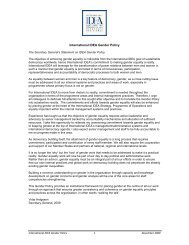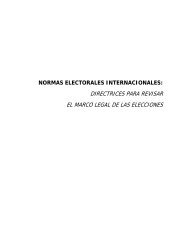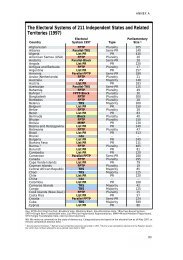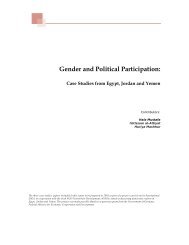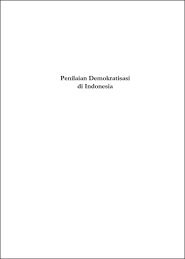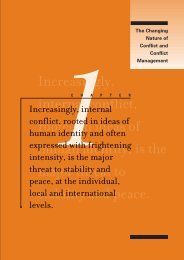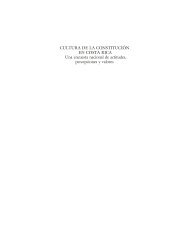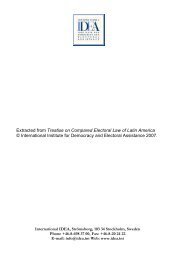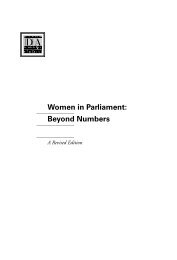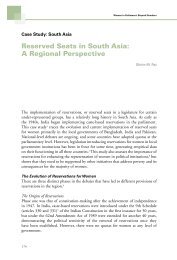The Role of State Constitutions in Protecting ... - International IDEA
The Role of State Constitutions in Protecting ... - International IDEA
The Role of State Constitutions in Protecting ... - International IDEA
Create successful ePaper yourself
Turn your PDF publications into a flip-book with our unique Google optimized e-Paper software.
(e) Similarly, <strong>in</strong> the matter <strong>of</strong> the right to establish an <strong>in</strong>stitution <strong>in</strong><br />
relation by the <strong>State</strong>, though there is no constitutional or other right for<br />
an <strong>in</strong>stitution to receive <strong>State</strong> recognition and though the <strong>State</strong> is entitled<br />
to impose reasonable conditions for receiv<strong>in</strong>g state recognition, e.g., as to<br />
qualifications, it cannot impose conditions for acceptance <strong>of</strong> which<br />
would virtually deprive a m<strong>in</strong>ority community <strong>of</strong> their right guaranteed<br />
by Art. 30 (1). Where, therefore, the state regulations debar scholars <strong>of</strong><br />
unrecognized educational <strong>in</strong>stitutions from receiv<strong>in</strong>g higher education or<br />
from enter<strong>in</strong>g <strong>in</strong>to public services, the right to establish an <strong>in</strong>stitution<br />
under Art. 30(1) cannot be effectively exercised without obta<strong>in</strong><strong>in</strong>g <strong>State</strong><br />
recognition that the <strong>in</strong>stitution must not receive any fees tuition fees <strong>in</strong><br />
the primary classes. For, if there is no provision <strong>in</strong> the <strong>State</strong> law or<br />
regulation as to how this f<strong>in</strong>ancial loss is to be recouped, <strong>in</strong>stitutions<br />
solely or primarily dependent upon the fees charged <strong>in</strong> the primary<br />
classes cannot exist at all.<br />
(f) M<strong>in</strong>ority <strong>in</strong>stitutions protected under Art. 30(1) are however, subject<br />
to regulation by the educational authorities <strong>of</strong> the <strong>State</strong> to prevent maladm<strong>in</strong>istration<br />
and to ensure a proper standard <strong>of</strong> education. But such<br />
regulation cannot go to the extent <strong>of</strong> virtually annihilat<strong>in</strong>g the right<br />
guaranteed by Art. 30 (1).<br />
Furthermore, the constitution directs every <strong>State</strong> to provide adequate facilities for<br />
<strong>in</strong>struction <strong>in</strong> the mother tongue at the primary stage <strong>of</strong> education to children<br />
belong<strong>in</strong>g to l<strong>in</strong>guistic m<strong>in</strong>ority groups and empowers the President to issue<br />
proper direction to any <strong>State</strong> <strong>in</strong> this behalf [Art. 350 A].<br />
Federal division <strong>of</strong> power<br />
India is a union <strong>of</strong> states, where the territories <strong>of</strong> the units <strong>of</strong> the federation may<br />
be altered or redistributed if the Union Executive and Legislature so desire. In<br />
practice this has been used to reorganize the states on l<strong>in</strong>guistic l<strong>in</strong>es. So, <strong>in</strong> effect,<br />
the federal design serves as a way to safeguard the <strong>in</strong>terest <strong>of</strong> l<strong>in</strong>guistic m<strong>in</strong>orities.<br />
S<strong>in</strong>ce the commencement <strong>of</strong> the Constitution, this power has been used by the<br />
Parliament to enact various acts for reorganization <strong>of</strong> states. Initially, we notice<br />
major reorganization <strong>of</strong> the boundaries <strong>of</strong> the different <strong>State</strong>s <strong>of</strong> India <strong>in</strong> the<br />
1950s’ by <strong>The</strong> <strong>State</strong>s Reorganization Act, 1956, <strong>in</strong> order to meet local and<br />
l<strong>in</strong>guistic demands. <strong>The</strong> reorganization <strong>of</strong> <strong>State</strong>s cont<strong>in</strong>ued and the next major<br />
change was <strong>in</strong>troduced by the Punjab Reorganization Act, 1966, by which the<br />
<strong>State</strong> <strong>of</strong> Punjab was split up <strong>in</strong>to <strong>State</strong> <strong>of</strong> Punjab and Haryana and the Union<br />
territory <strong>of</strong> Chandigarh. <strong>The</strong> recent reorganization <strong>of</strong> <strong>State</strong>s and carv<strong>in</strong>g out <strong>of</strong><br />
the states <strong>of</strong> Chhattisgarh, Jharkhand and Uttaranchal <strong>in</strong> the year 2000 is a step<br />
further <strong>in</strong> this direction.<br />
<strong>The</strong> Indian constitution <strong>in</strong>troduces a federal system as the basic structure <strong>of</strong><br />
government <strong>of</strong> the country, though there is a strong admixture <strong>of</strong> unitary bias and<br />
26




